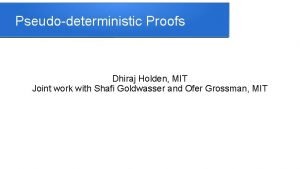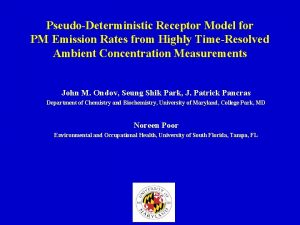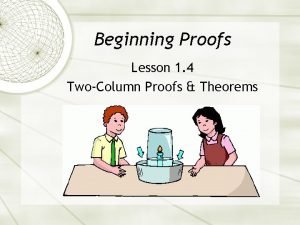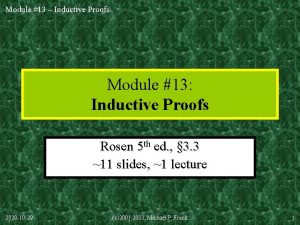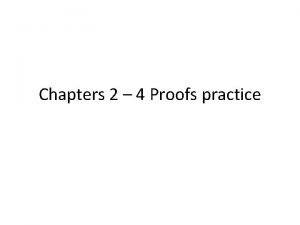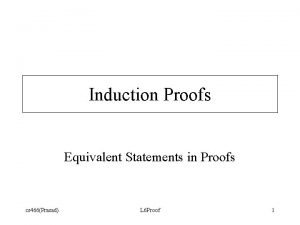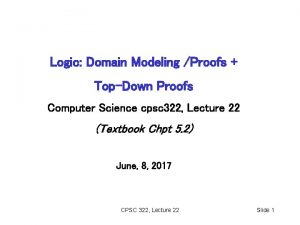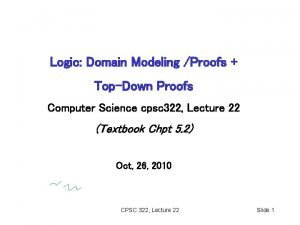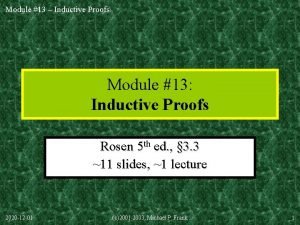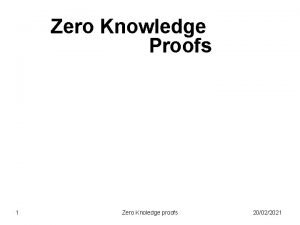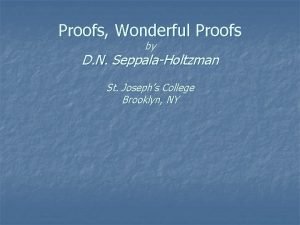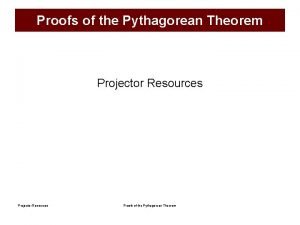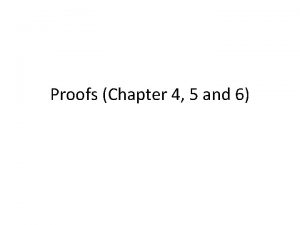Pseudodeterministic Proofs Dhiraj Holden MIT Joint work with

![Pseudo-determinism[GG 11] A pseudo-deterministic (psd) algorithm is a randomized algorithm for a search problem Pseudo-determinism[GG 11] A pseudo-deterministic (psd) algorithm is a randomized algorithm for a search problem](https://slidetodoc.com/presentation_image/a617ef1ae984d208eadce42ced9bd2dd/image-2.jpg)

![Examples in Prior Work [GGR 12] Sublinear pseudo-deterministic algorithms [GG 15] pseudo-deterministic NC algorithms Examples in Prior Work [GGR 12] Sublinear pseudo-deterministic algorithms [GG 15] pseudo-deterministic NC algorithms](https://slidetodoc.com/presentation_image/a617ef1ae984d208eadce42ced9bd2dd/image-4.jpg)
![Subsequent Work [H 17] gives an average-case result about pseudodeterministic algorithms for search-BPP [GL Subsequent Work [H 17] gives an average-case result about pseudodeterministic algorithms for search-BPP [GL](https://slidetodoc.com/presentation_image/a617ef1ae984d208eadce42ced9bd2dd/image-5.jpg)



![This is different than • Unique-SAT: In Valiant-Vazirani [VV], a number of instances are This is different than • Unique-SAT: In Valiant-Vazirani [VV], a number of instances are](https://slidetodoc.com/presentation_image/a617ef1ae984d208eadce42ced9bd2dd/image-9.jpg)












- Slides: 21

Pseudo-deterministic Proofs Dhiraj Holden, MIT Joint work with Shafi Goldwasser and Ofer Grossman, MIT
![PseudodeterminismGG 11 A pseudodeterministic psd algorithm is a randomized algorithm for a search problem Pseudo-determinism[GG 11] A pseudo-deterministic (psd) algorithm is a randomized algorithm for a search problem](https://slidetodoc.com/presentation_image/a617ef1ae984d208eadce42ced9bd2dd/image-2.jpg)
Pseudo-determinism[GG 11] A pseudo-deterministic (psd) algorithm is a randomized algorithm for a search problem that on the same input outputs the same output (we will call it the canonical answer) with high probability Different than guaranteeing a unique answer [LD 08] Reproducibility Correctness Amplification

Search problems
![Examples in Prior Work GGR 12 Sublinear pseudodeterministic algorithms GG 15 pseudodeterministic NC algorithms Examples in Prior Work [GGR 12] Sublinear pseudo-deterministic algorithms [GG 15] pseudo-deterministic NC algorithms](https://slidetodoc.com/presentation_image/a617ef1ae984d208eadce42ced9bd2dd/image-4.jpg)
Examples in Prior Work [GGR 12] Sublinear pseudo-deterministic algorithms [GG 15] pseudo-deterministic NC algorithms for bipartite matching [OS 16] a sub-exponential time psd algorithm for finding a prime of length n on input n, that works for infinitely many input lengths
![Subsequent Work H 17 gives an averagecase result about pseudodeterministic algorithms for searchBPP GL Subsequent Work [H 17] gives an average-case result about pseudodeterministic algorithms for search-BPP [GL](https://slidetodoc.com/presentation_image/a617ef1ae984d208eadce42ced9bd2dd/image-5.jpg)
Subsequent Work [H 17] gives an average-case result about pseudodeterministic algorithms for search-BPP [GL 18] proves that logarithmic space has repeatable randomized algorithms given a logarithmic number of bits

Today: Pseudo-deterministic Interactive Proofs In this talk, we will consider what happens when there is a powerful prover to help a polynomial time verifier to find a canonical answer y per input x so that: An honest prover can enable the verifier to output the canonical answer y with high probability over verifier’s coins No cheating prover will be able to make the verifier output a different answer than the canonical one with high probability in addition to the standard notion of soundness

Pseudo Deterministic Interactive Proofs Let R be a relation and LR : x s. t. ∃y s. t. R(x, y)=1 Input: x Prover P Verifier V Output Solution y or rejects Completeness : x in LR ∃P s. t. Pr[V output y s. t. R(x, y)=1] >2/3 Soundness: x not in LR for all P‘, Pr[V rejects x]>2/3 CANONICAL: x in LR ∃y ⇒ for all P’ : Pr[Verifier outputs y’≠y] <1/3

Application: Generating parameters for cryptographic systems • Central authority (NIST) wants to choose a common cryptographic parameter on size n, but is untrusted • Use pseudo-deterministic interactive proofs to verify that NIST generated a canonical cryptographic parameter • Example: NIST picks prime p, generator g 8
![This is different than UniqueSAT In ValiantVazirani VV a number of instances are This is different than • Unique-SAT: In Valiant-Vazirani [VV], a number of instances are](https://slidetodoc.com/presentation_image/a617ef1ae984d208eadce42ced9bd2dd/image-9.jpg)
This is different than • Unique-SAT: In Valiant-Vazirani [VV], a number of instances are generated, one of which has a unique solution with high probability • Single Valued NP functions: Examined by Hemaspaandra, Naik, Ogihara, and Selman [HNOS] is a deterministic version of pseudo-deterministic interactive proofs

Easy: The Unbounded-round Case For any search problem in PSPACE where the answers are polynomially bounded, finding the lexicographically first answer is in PSPACE Since IP = PSPACE, an unbounded-round interactive proof can give the lexicographically first answer to the verifier and convince the verifier with high probability

Pseudo-deterministic AM

Psd. MA (bounded rounds)

Our Main Results: the bounded case • • • A constant-round psd. AM protocol for finding an isomorphism between two graphs More generally, Search-PAM ∩ co. AM is in psd. AM Vice versa, psd. AM is in search-Ppromise-AM ∩ co. AM (similarly for MA) No NP-complete problem can be in psd. AM unless the polynomial hierarchy collapses Give a psd. MA algorithm with subexponential-time verifier for all of search-BPP

Pseudo-deterministic graph isomorphism Show a protocol where on input (G 0, G 1) the verifier guarantees that it receives the lexicographically first isomorphism f between G 0 and G 1, assuming that one exists (if an isomorphism does not exist the algorithm easily checks that and returns ┴) Idea: The protocol computes the lexicographically first isomorphism vertex-by-vertex (in parallel) For illustration, verifier uses private coins

On input G 0=(V, E), G 1=(U, E’) Perform all stages in parallel Say the correct f(vi) already established for 1≤i≤k-1 Stage k: Prover claim f(vk)=ur For every vertex s<r: Prove graph non-isomorphism of (D 1, D 2) where D 1: Label v 1…vk in G 0 D 2: Label f(v 1)…f(vk-1) us as 1…k in G 1 Non-isomorphism proof Graph non-isomorphism [GMW, GS] is in AM

The Main Theorem • Search-PAM ∩ co. AM is in psd. AM • psd. AM is in search-Ppromise-AM ∩ co. AM This is also true for AM replaced with MA

The Main Theorem: part 1 search-PAM ∩ co. AM is contained in psd. AM q 1, a 1, q 2, a 2, …, qk, ak Interactive proof to show a 1, a 2, …, ak are correct for q 1, …, qk Verified by running search. P algorithm with answers a 1, a 2, …, ak

Proof of the Main Theorem: Part 2 Claim: psd. AM is contained in search-Ppromise-AM ∩ co. AM To simulate psd. AM on input x: ask the oracle “Is the ith bit of the canonical answer to the psd. AM interactive proof a 1? ” and use the answers to obtain y such that R(x, y) holds This problem is a promise problem in AM ∩ co. AM since: there is only an answer when a canonical answer exists when no such answer exists it is undefined

Subexponential psd. MA for search -BPP Subexponetial-time psd. MA allows the verifier subexponential time We show that search-BPP is in subexponential-time psd. MA To do this we observe there exists a hard function f in subexponential-time MA ∩ co. MA that does not have polysize circuits

Subexponential psd. MA for search -BPP Truth-table tt(1, …, k) of hard function f and Witnesses w 1, w 2, …, wk for f • Check tt is accurate using w’s • Use tt to construct PRG G [NW 94] • Run search-BPP machine with randomness G(s 1), G(s 2), …, G(sj) on all seeds • Output the first answer found

Open Problems Does there exist a psd. AM protocol for every problem in TFNP? Can we find approximate short vectors in lattices in psd. AM Can we find a prime p for a given length in psd. AM? (The main issue here is how can the prover prove that the prime is canonical in some way? )
 Dhiraj holden
Dhiraj holden Unknown angle proofs-proofs with constructions
Unknown angle proofs-proofs with constructions Unknown angle proofs lesson 9
Unknown angle proofs lesson 9 Dhiraj dave
Dhiraj dave Proofs of work and bread pudding protocols
Proofs of work and bread pudding protocols Lamb grading
Lamb grading Intertransverse ligament
Intertransverse ligament Permanent joint examples
Permanent joint examples Memorandum joint venture
Memorandum joint venture Break joint vs spool joint
Break joint vs spool joint Ellipsoid joints
Ellipsoid joints Randy adderson personality
Randy adderson personality Cherry valance personality traits
Cherry valance personality traits Catcher in the rye sunny
Catcher in the rye sunny What was holden's reaction to allie's death
What was holden's reaction to allie's death The catcher in the rye poem
The catcher in the rye poem Catcher in the rye 13-15
Catcher in the rye 13-15 Chapter 16 catcher in the rye
Chapter 16 catcher in the rye Joanna holden
Joanna holden Jane gallagher inner desires
Jane gallagher inner desires Flow cytometry
Flow cytometry Robert burns catcher in the rye
Robert burns catcher in the rye
